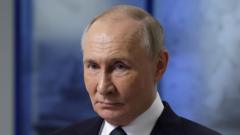Mounting tensions between the U.S. and Russia unfold as President Putin’s aggressive strategies continue amidst a backdrop of failed peace talks and ceaseless drone strikes on Ukrainian cities.
Putin's Relentless Tactics Challenge Peace Efforts Amidst Ongoing Conflict

Putin's Relentless Tactics Challenge Peace Efforts Amidst Ongoing Conflict
Frustration in Washington as Russian advances complicate attempts at negotiation.
In recent developments, President Vladimir V. Putin's actions have sparked concern among U.S. officials, especially after he suggested a temporary government might be necessary in Ukraine, under U.N. oversight, prolonging the conflict further. Despite a sympathetic U.S. administration, Putin's unwillingness to negotiate genuinely poses a serious challenge to any potential cease-fire agreements.
For two consecutive months, the White House has attempted to reach out to the Kremlin, hoping for a constructive dialogue about peace in the region. In turn, however, Putin's forces escalate their bombardment on both the front lines and deep within Ukraine. Although he has expressed an openness to cooperatively engage, his peace proposals are layered with stringent conditions that make any swift resolution unlikely.
Recent discussions have hinted at a limited truce in the Black Sea, but these talks have meandered without resolution. During a public appearance in the Arctic, Putin posited that Ukraine may need a new governing body to facilitate a broader political solution, undermining President Volodymyr Zelensky’s legitimacy, a point Russia has long maintained throughout the conflict.
Former President Donald Trump expressed his frustration in response to Putin's comments during an NBC News interview, indicating he could impose tariffs on countries acquiring Russian oil. This strategy could significantly impact Russia's economic foundation for its military operations, reflecting the rising urgency in Washington to alter the trajectory of negotiations.
As drone attacks continue to rattle Ukrainian cities, the prospect for a peaceful resolution appears increasingly remote, complicating not only the immediate dynamics in Ukraine but also the global responses to Russian aggression. With peace efforts hanging in the balance, the world watches closely for how the situation will unfold in the coming weeks.
For two consecutive months, the White House has attempted to reach out to the Kremlin, hoping for a constructive dialogue about peace in the region. In turn, however, Putin's forces escalate their bombardment on both the front lines and deep within Ukraine. Although he has expressed an openness to cooperatively engage, his peace proposals are layered with stringent conditions that make any swift resolution unlikely.
Recent discussions have hinted at a limited truce in the Black Sea, but these talks have meandered without resolution. During a public appearance in the Arctic, Putin posited that Ukraine may need a new governing body to facilitate a broader political solution, undermining President Volodymyr Zelensky’s legitimacy, a point Russia has long maintained throughout the conflict.
Former President Donald Trump expressed his frustration in response to Putin's comments during an NBC News interview, indicating he could impose tariffs on countries acquiring Russian oil. This strategy could significantly impact Russia's economic foundation for its military operations, reflecting the rising urgency in Washington to alter the trajectory of negotiations.
As drone attacks continue to rattle Ukrainian cities, the prospect for a peaceful resolution appears increasingly remote, complicating not only the immediate dynamics in Ukraine but also the global responses to Russian aggression. With peace efforts hanging in the balance, the world watches closely for how the situation will unfold in the coming weeks.





















